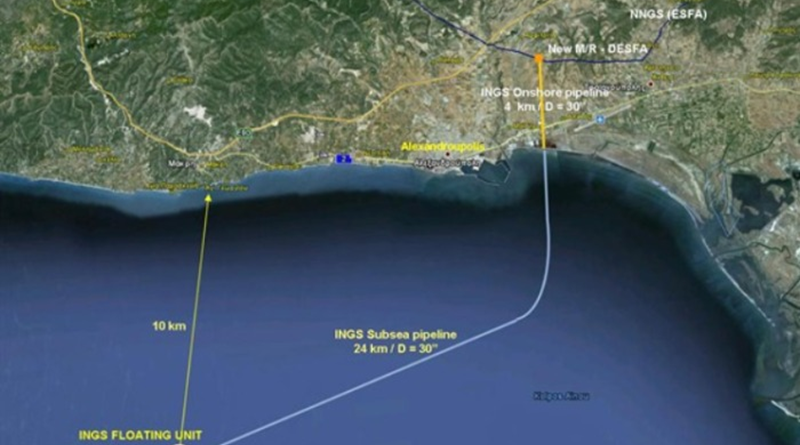Mysterious Shutdown of the Alexandroupolis FSRU
Increasing Issues with Non-Russian Gas Supplies in the Region
Following the nearly two-week suspension of production at the “Shah Deniz 2” field, which negatively affected not only Azerbaijani natural gas deliveries via the Trans-Adriatic Pipeline but also its positioning in the regional gas market at the peak of the winter season, a new “strange” incident occurred at the LNG terminal near Alexandroupolis—another potential entry point for non-Russian gas into the region. The terminal unexpectedly ceased supplying gas to the DESFA network.
Interruption of Terminal Operations
On January 23, a statement appeared on the website of Gastrade announcing that the terminal was halting operations due to technical issues. Unlike the case of the teminated gas supply from the main drilling platform of “Shah Deniz 2,” in this case, no explanations were provided. The following day, the Alexandroupolis terminal operator adopted a more upbeat tone, stating that regasification services were resuming with a maximum expected capacity of 31,300,000 kWh/d. This indicated partial but functional operation.
However, data from transmission network operators showed no gas flow from the terminal. This raised serious unanswered questions. On January 28, Gastrade again announced that regasification services would remain unavailable until further notice. Industry sources suggested this “further notice” might come by the end of the week (February 8), but no official confirmation appeared on the company’s website. This suggests that management is uncertain about both the nature of the problem and the timeline for its resolution—a situation that hardly inspires confidence among market participants, key partners, and customers.
Meanwhile, Russian Gas Supplies via Turkey Increase
This incident occurred during peak winter consumption, amid forecasts of low temperatures and decreasing gas storage levels in Eastern and Central Europe. At the same time, the volume of Russian natural gas entering via “TurkStream” at the “Strandzha-2” entry point has significantly increased. While average entry levels last year stood at 41-42 million cubic meters per day, they now regularly exceed 50-51 million, approaching the pipeline’s technical capacity limits.
It is no coincidence that some business circles link the Alexandroupolis terminal shutdown to the “need to free up market space” for increased Russian gas deliveries. The supply gaps left by undelivered LNG—including American, Qatari, and Algerian shipments—are swiftly filled with Russian natural gas.
The Russian Connection in the FSRU
Speculation about a “Russian connection” surrounding the Alexandroupolis FSRU revolves around Kostas Kopelouzos, head of the Kopelouzos Group—a longtime Gazprom partner in Greece. There are suspicions (without public evidence) that he maintains ties with Russian intelligence services. The fact that the terminal ceased operations precisely at a time of critical need for alternative supplies has refueled old concerns.
Russia and Gazprom have a vested interest not only in the terminal’s shutdown but also in preventing it from becoming a stable alternative source for the region.
Kostas Kopelouzos, along with another key Russian-linked player in Greece, Ivan Stavridis, was among the bidders for the privatization of the strategic Alexandroupolis port. This port has gained strategic importance for NATO in the context of the war in Ukraine. Although their offer was among the leading bids, the Greek government rejected it following U.S. intervention, citing geopolitical concerns with Russian interests behind the bid.
The LNG terminal project at the port remained a ‘consolation prize’ for the Kopelouzos Group. After several years of delays, it became operational on January 1, 2023. However, just two years later, it has ceased operations. In the meantime, the strategic location of the FSRU offers an excellent vantage point for monitoring incoming and outgoing traffic at the Alexandroupolis port.
Business Reasons Behind the Terminal Shutdown
One of the most plausible business reasons for the terminal’s suspension is the lack of minimum utilization levels and LNG volumes required for profitable operation. This is due to the price dumping of Russian pipeline gas supplied to the region via Turkey—through “TurkStream” and “Blue Stream.”
With discounts of around 10% compared to the Western European TTF index, Russian gas makes LNG economically uncompetitive. Traders avoid the risk of new LNG deliveries through Alexandroupolis, and even contracted shipments are redirected to other terminals, including those in Turkey. This further worsens the financial results of Gastrade, the terminal’s operator.
Bulgaria’s Essential “Contribution”
From the outset, it was clear that the Kopelouzos Group was not entirely confident in the LNG terminal’s business model, particularly in its ability to attract sufficient equity and loan capital. This is why the project company opted for a floating regasification and storage unit instead of expensive onshore infrastructure.
Ultimately, Bulgarian state-owned companies Bulgargaz (which reserved a capacity of 1 billion cubic meters annually) and Bulgartransgaz (which acquired a 20% stake in the terminal) joined the project, primarily for “strategic considerations.”
Annual reports from Bulgartransgaz reveal that payments to Gastrade for this 20% stake were made in multiple installments, ultimately reaching nearly €30 million—a significantly overestimated price in hindsight, given the company’s financial results in 2024 and its outlook for 2025. This suggests that the participation of Bulgarian companies was driven primarily by “strategic considerations,” fully aware of the lack of real economic logic.
The real issue is that, for years, political considerations have dominated the decision-making of both Bulgartransgaz and Bulgargaz—whether in the deal with Botas, the Turkish Stream pipeline, or the expansion of the Chiren underground gas storage facility—all while financial losses continue to mount.
Today, however, these commitments have become a burden for Bulgarian companies. Bulgargaz is paying for its reserved capacity of 1 bcm per year in Alexandroupolis regardless of actual usage, while also maintaining additional supply contracts with Azerbaijan (1 bcm per year) and Turkey’s Botas (1.8 bcm per year). These factors have driven the company into a financial tailspin, accompanied by a dramatic decline in market share—from 93% in 2022 to below 60% in 2024.
The Key Question Remains Unanswered
The situation surrounding the Alexandroupolis LNG terminal shutdown leaves many questions unanswered. The most pressing of these is: Are technical issues truly behind the floating platform’s suspension, or are geopolitical and economic interests at play?
Ilian Vassilev




